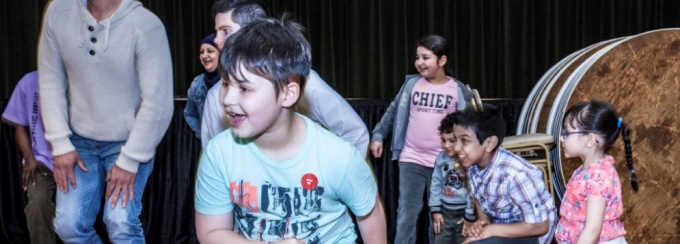Understanding the Global within the Local: Educational Policy and Programmatic Supports for Displaced Youth

Photo by Jewish Family Services
Largescale displacement, both within and across international borders, has occurred on a scale not witnessed since the Second World War.
This contemporary spike in and differentiation of movement has unique temporal sociopolitical, economic, and cultural markers (Lemke, 2017). Such movement also poses important challenges to educational policies and practices, which aim to meet the unique social and emotional needs of youth – who now constitute staggering numbers of overall globally displaced populations. Given shifting youth demographics in New York State and limited research in the area, identifying how policy and programming assist or hinder addressing displaced student mental health, and gaining insight into school and/or staff needs related to such policy and programming, have important implications for the field of education and beyond.
Funded by the Community for Global Health Equity, this seed project accounts for macro- and micro-level factors weighing on the ability of educational personnel to address the mental health needs of students experiencing high rates of displacement-based trauma. Specifically, the aim of this research is to examine how educational leaders, teachers, counselors, and support staff leverage policy and programmatic supports available to refugee and other displaced students. This study is attentive to youth forcibly moved from their homes, such as in the case of Puerto Rican students in the aftermath of Hurricane Maria, and those granted refugee status. We know that exposure to violence is linked to a range of short-and long-term health and academic problems, with displaced youth often facing a range of negative circumstances prior to and post-movement. Finding ways to sustain a culturally sensitive and trauma-informed school climates (Nickerson et al., 2017) may be particularly vital for this student population.
Research Objectives
- Identify what we know from the literature about displaced youth trauma, programmatic interventions, and relevant policy
- Conduct a qualitative case study of one Western New York public high school serving high numbers of displaced students
- Identify how policy and programming assist or hinder serving displaced students, and school and/or staff needs related to such policy and programming
- Develop a theoretical framework for better serving the needs of displaced students, and where requested by the research site, assist with professional development based on qualitative results
Research Methods
Research methods involve a range of qualitative techniques. Document collection and research site observations currently are on-going. Individual semi-structured interviews with administrative-level personnel (N = 6) and three focus groups with core and support teaching staff (N = 19) also are underway. Both individual interviews and focus groups examine school culture and staff understanding of policies and programs related to, dynamics affecting, and hindrances in assisting displaced youth with the goal of generating theory that can be explored in more generalizable studies (Yin, 2003). To protect the research site and its participants, strict anonymity is being followed at all levels of the study.
How is this Innovative?
Though a range of disciplines examine policies concerning and dynamics of displacement within the United States, less of this research explores normative understanding around and implementation of these policies as they relate to U.S. school practices. Guided by critical educational and social-ecological theories, this study builds on interdisciplinary research concerned with youth displacement policy, trauma and abuse, and violence intervention and prevention. Given the limited research on the ways policy and programming assist or hinder serving the social, emotional, and mental health of displaced students, and school and/or staff needs related to such policy and programming, this study aims to offer an important contribution to the research literature.
The Long View
This team aims to highlight the importance of sociopolitical, normative, and economic context, as well as policy and programmatic supports necessary to serve the overall well-being of displaced students in one U.S. public school. To this end, the study will develop a theoretical framework for better serving the needs of displaced students, and where requested by the research site, assist with professional development based on qualitative results. The team also will seek additional funding to scale up the study so to more closely examine additional school support structures within the surrounding neighborhood community and among local policy actors. Such funds would permit a more extensive “mapping” of “the global within the local” and understanding of the extent to which non-educational actors shape the lives of displaced students and their families, as well as the daily work done on their behalf by K-12 educational personnel. Such work requires a research team having qualitative expertise applied to educational policy-making, leadership and pedagogical practice, violence intervention and prevention, and community engagement.
References
Lemke, M. (2017). Trafficking and immigration policy: Intersections, inconsistencies, and implications for public education. Educational Policy, 31(6), 743–763. doi: 10.1177/0895904817719528
Nickerson, A. B., Mayer, M. J., Cornell, D. G., Jimerson, S. R., Osher, D., & Espelage, D. L. (2017). Violence prevention in schools and communities. In M. Casas, L. Suzuki, C. Alexander, & M. Jackson (Eds.), Handbook of multicultural counseling (4th ed.) (pp. 323-331). Thousand Oaks, CA: Sage.
Yin, R. K. (2003). Case study research: Design and methods. Thousand Oaks, CA: Sage.
Recent Publications
1. Lemke, M., and A. Nickerson. "Educating Refugee and Hurricane Displaced Youth in Troubled Times: Countering the Politics of Fear through Culturally Responsive and Trauma-Informed Schooling." Children's Geographies (2020): 1-15.
There is a growing body of interdisciplinary scholarship on the traumas inherent in forced migration and the corresponding educational and mental health needs of displaced youth. Yet, there is limited empirical research on how political and normative culture affects this relationship. This article presents findings from a larger multi-method qualitative case study that utilized observations, document collection, interviews, and focus groups to investigate how US high school personnel leveraged available policy and programmatic supports to address displaced student educational needs. Educator knowledge of student cultural histories coupled with awareness of how trauma can disrupt social and cognitive development was found to support anti-deficit thinking among staff and positive student transitioning into the US educational system within the current political environment. Building on literature concerned with the politics of education and ways to address structural oppression through culturally responsive and trauma-informed practices, this research develops a framework for understanding important intersections between schooling practices, context-specific resettlement culture, and student experience.
2. Lemke, M., and S. (Eds.). Shubin. "Child and Youth (Dis)Placement: New (B)Orderings of Vulnerability, Rights, and Policy Response." Children's Geographies, no. Fall 2019 Special Issue (2019).
Articles and Reflections
Our Team
Co-Lead, Refugee Health and Wellbeing team; Associate Professor
Educational Leadership and Policy
Phone: 716-645-3448
Email: nickersa@buffalo.edu



